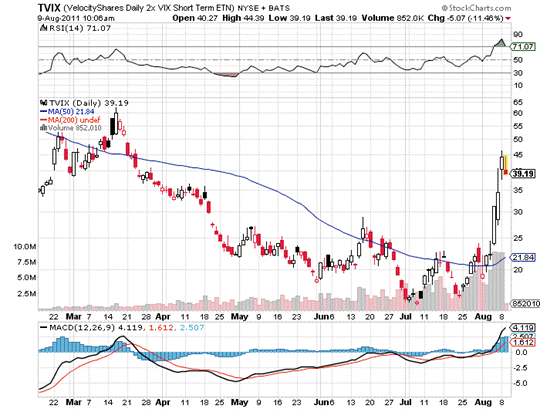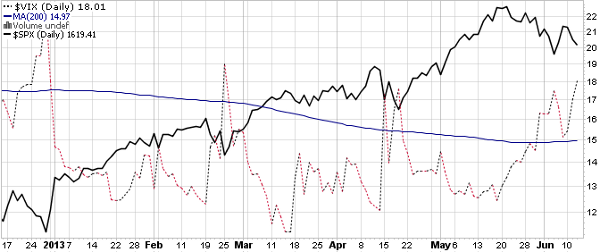Profiting From Fear With ExchangeTraded VIX Notes
Post on: 12 Май, 2015 No Comment

VIX rises as stocks fall
Volatility is a major factor in equity and option investments, and the Chicago Board Options Exchange Market Volatility Index (VIX), has been a popular and carefully-watched indicator almost from the moment it was launched.
Though VIX may or may not be a rigorous substitute for risk, investors and financial commentators nevertheless watch this indicator to measure the tenor of investor attitudes about the market and the likely path of short-term trading.
As a financial indicator in its own right, however, it is also possible for investors to use the VIX as a means towards profits or the protection of their portfolios. (Discover a new financial instrument that provides great opportunities for both hedging and speculation. Check out Introducing The VIX Options .)
VIX – What It Is (And Is Not)
The VIX is a weighted index that blends together several S&P 500 index options, with the notion that the greater the premiums on these options, the more uncertainty about the direction of the market. In design, then, it is the square root of the 30-day period returns, and it is expressed as percentage points. As such, it is supposed to be a forward-looking representation of what sort of volatility the markets expect in the short term.
Though VIX is frequently used as a measure of investor fear (or complacency), that is really not what it measures, as consensus optimism or pessimism would not result in an especially high VIX. Accordingly, it should probably be better thought of as the “uncertainty index” (though it is fair to admit that the there is a strong link between fear and uncertainty on the Street ). Nevertheless, there is a negative correlation between the VIX and S&P 500 Index (meaning that they move in opposite directions).
It is also important to note that the VIX is not technically a direct measure of risk. There is ample debate about what risk really is, and some investors do use past or projected volatility as a proxy for risk. That said, risk should be better thought of as the historical volatility of portfolio movements, not the expected up-and-down swings along the path.
How to Profit from the VIX
Investors have a variety of choices for incorporating VIX into their portfolios, and exchange traded notes (ETNs) are one of the most popular. Similar to ETFs, ETNs allow investors to buy and sell instruments designed to replicate certain target indices. In the case of VIX, these ETNs hold a collection of rolling VIX futures contracts.
There are several worthwhile attributes to ETNs like the iPath S&P 500 VIX Short-Term Futures ETN (NYSE:VXX ). ETNs are relatively cheap to buy and sell and any broker can handle the trades (unlike futures and options). Because they are cheap to own and trade, they make for a fairly good, simple alternative for portfolio hedging.
It is important for investors to realize that these are NOT identical to the spot VIX. Moreover, because volatility is a mean-reverting phenomenon, the VIX ETNs can deviate from spot VIX – trading higher than they should during low volatility (on the presumption that volatility will increase) and lower during periods of high volatility.
Investors should also be aware that leveraged VIX ETNs have certain drawbacks as well. Because of the repositioning that occurs in the portfolio, there is a phenomenon called “volatility lag” that hurts performance. While leveraged volatility ETNs do come closer to replicating the actual performance of VIX, these instruments are really only effective when held for short periods of time (as volatility lag eats away at the returns over time).

VIX Futures and Options
More sophisticated investors can also opt to trade options and futures on the VIX index itself. Options and futures offer greater leverage to investors, and so greater return potential on a successful trade. That said, there are some factors that investors should keep in mind. Options and futures often carry higher commissions than equity trades and investors in futures will be required to maintain a minimum margin. Investors should also be aware of different tax treatment on gains and losses, particularly for futures contracts. Options and futures are also investments with a definite lifespan; not only do investors have to be right about the direction of volatility, but also the timeframe.
Options
VIX options are European-style options. meaning that they can only be exercised upon expiration. What’s more, these options expire on Wednesdays (unlike the more traditional Friday expiration for options), and settlements are in cash. While the built-in leverage of options serves to produce magnified returns, investors should note that these options do trade on expected forward value and can deviate from the spot VIX.
In other words, because of the European-style exercise and the mean-reversion of volatility, VIX options will often trade at lower value than what seems appropriate during periods of high volatility (and vice versa in low volatility periods), particularly early on in the term of the option.
Futures
Like options, VIX futures are inherently leveraged and tend to better replicate the movements of spot VIX than the ETNs. Here again, though, investors should realize that the value of the futures contract is based on a forward-looking assessment of VIX; actual futures can be lower, higher, or equal the spot VIX based upon that outlook and the amount of time left before settlement. (Find out how traders can use this tool to identify shorting opportunities. See Using The VIX For Shorting .)














